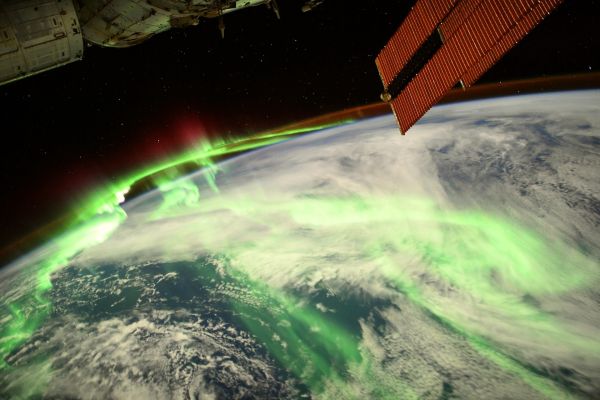Superbright aurora lights up Earth's night side in incredible image from space

An astronaut aboard the International Space Station (ISS) captured a stunning new photo of the luminous green and red lights of an aurora hugging clouds swirling around Earth's night side.
"Another aurora but this one is special as it is so bright," European Space Agency astronaut Thomas Pesquet wrote on Instagram and Twitter. "It is the full Moon lighting up the shadow side of Earth almost like daylight." Pesquet snapped the photo on Aug. 20.
It's not clear whether the lights were the northern lights, known as the aurora borealis, or their southern counterpart, the aurora australis, according to Business Insider. Auroras, named after the Roman goddess of dawn, can be seen clearly from the ground and from space, such as aboard the ISS, where many astronauts have snapped photos of the ghostly light shows.
Related: Best equipment for aurora photography
More: Northern lights: 8 dazzling facts about auroras
Auroras result from the interaction between the solar wind — a stream of charged particles from the sun — and Earth's magnetic field. The magnetic field accelerates the particles as they enter Earth's upper atmosphere, where they collide with atoms and molecules, according to NASA.
Related: Where and how to photograph the aurora
Another #aurora but this one is special as it is so bright. It is the full Moon 🌕 lighting up the shadow side of Earth 🌎 almost like daylight. 🌞 #MissionAlpha https://t.co/vhJVPNqE1D pic.twitter.com/bcx6NNZsrjSeptember 24, 2021
This collision causes atmospheric atoms and molecules to gain energy, which they then release as light. "When we see the glowing aurora, we are watching a billion individual collisions, lighting up the magnetic field lines of Earth," NASA says. Different ions in the atmosphere emit different colors of light; oxygen atoms emit green or red light, while nitrogen atoms emit orange or red light, Live Science previously reported.
Breaking space news, the latest updates on rocket launches, skywatching events and more!
Earth's magnetic field guides the solar particles toward the poles, which is where auroras are typically observed. But during major geomagnetic storms, auroras can be observed in areas outside the poles, according to the National Oceanic and Atmospheric Administration (NOAA). Geomagnetic storms happen when enormous amounts of plasma, or charged particles, escape the sun's atmosphere and hit our planet's magnetic field, Live Science previously reported.
Originally published on Live Science.


